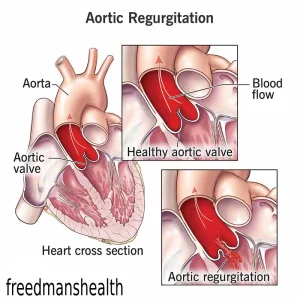Overview
Diagnosis of Aortic Valve Regurgitation
Diagnosis of aortic valve regurgitation begins with a physical exam and a review of your symptoms and health history, including family history. A healthcare professional may listen to the heart with a stethoscope to detect a heart murmur and check blood pressure. Referral to a cardiologist is often needed for further evaluation.
Common diagnostic tests include:
-
Echocardiogram: Uses sound waves to create images of the heart and assess blood flow through the aortic valve and aorta. A transesophageal echocardiogram provides more detailed internal images.
-
Electrocardiogram (ECG or EKG): Measures electrical activity of the heart to check heart rate and rhythm.
-
Chest X-ray: Detects enlargement of the heart or aorta and evaluates lung condition.
-
Cardiac CT scan: Detailed imaging of the heart and aorta, useful to detect tears.
-
Exercise or stress tests: Assess heart response to physical activity and reveal exercise-related valve symptoms.
-
Cardiac MRI: Detailed images of the heart and aortic valve structure.
-
Cardiac catheterization: Evaluates severity and may be used before valve surgery; involves threading a catheter to the heart and using dye for imaging.
Heart valve disease stages:
-
Stage A: At risk, risk factors present.
-
Stage B: Mild/moderate valve disease, no symptoms.
-
Stage C: Severe valve disease without symptoms.
-
Stage D: Severe valve disease with symptoms.
Treatment of Aortic Valve Regurgitation
Treatment depends on severity, symptoms, and disease progression. Goals are to relieve symptoms and prevent complications.
Monitoring and Lifestyle:
-
Regular checkups and echocardiograms.
-
Heart-healthy lifestyle changes, including diet, exercise, and blood pressure control.
Medications:
-
Manage symptoms.
-
Reduce risk of complications.
-
Lower blood pressure.
Surgical and Procedural Options:
-
Aortic valve repair: Surgeons may separate fused valve flaps, reshape or remove tissue, or patch holes. Catheter-based procedures may be used in certain cases.
-
Aortic valve replacement: Damaged valve is replaced with a mechanical or biological tissue valve.
-
Minimally invasive surgery / TAVR: Transcatheter aortic valve replacement uses smaller incisions than open-heart surgery.
-
Ross procedure: Pulmonary valve is used to replace the aortic valve, with a donor valve replacing the pulmonary valve.
Notes:
-
Biological tissue valves may deteriorate over time and require replacement.
-
Mechanical valves require lifelong blood-thinning medications to prevent clots.
-
The choice of procedure depends on age, symptoms, overall health, and whether other heart surgeries are needed.
Advertisement

